The Effect of Physical Training on Peripheral Blood Mononuclear Cell Ex Vivo Proliferation, Differentiation, Activity, and Reactive Oxygen Species Production in Racehorses
Abstract
1. Introduction
2. Materials and Methods
2.1. Animals and Blood Sampling
2.2. Cell Isolation and Culture
2.3. Cell Staining
2.4. Flow Cytometry Analysis
2.5. ELISA
2.6. Data Enumeration and Statistical Analysis
3. Results
3.1. Lymphocyte Proliferation
3.2. T Lymphocyte Phenotype
3.3. Monocyte Phenotypes
3.4. ROS Production
3.5. Cytokine Production
4. Discussion
4.1. Lymphocytes Proliferation
4.2. T Lymphocytes
4.3. Monocytes
4.4. Reactive Oxygen Species Production
4.5. Cytokine Production
4.6. Main Limitations
5. Conclusions
Supplementary Materials
Author Contributions
Funding
Conflicts of Interest
References
- Campbell, J.P.; Riddell, N.E.; Burns, V.E.; Turner, M.; Van Zanten, J.J.C.S.V.; Drayson, M.T.; Bosch, J.A. Acute exercise mobilises CD8+ T lymphocytes exhibiting an effector-memory phenotype. Brain Behav. Immun. 2009, 23, 767–775. [Google Scholar] [CrossRef] [PubMed]
- Gleeson, M.; Bishop, N.C.; Stensel, D.J.; Lindley, M.R.; Mastana, S.S.; Nimmo, M.A. The anti-inflammatory effects of exercise: Mechanisms and implications for the prevention and treatment of disease. Nat. Rev. Immunol. 2011, 11, 607–610. [Google Scholar] [CrossRef] [PubMed]
- Nieman, D.C.; Wentz, L.M. The compelling link between physical activity and the body’s defense system. J. Sport Health Sci. 2019, 8, 201–217. [Google Scholar] [CrossRef] [PubMed]
- Kakanis, M.; Peake, J.; Hooper, S.; Gray, B.; Marshall-Gradisnik, S. The open window of susceptibility to infection after acute exercise in healthy young male elite athletes. J. Sci. Med. Sport 2010, 13, e85–e86. [Google Scholar] [CrossRef]
- MacKinnon, L.T. Special feature for the Olympics: Overtraining effects on immunity and performance in athletes. Immunol. Cell Biol. 2000, 78, 502–509. [Google Scholar] [CrossRef]
- Wood, J.L.N.; Newton, J.R.; Chanter, N.; Mumford, J.A. Association between Respiratory Disease and Bacterial and Viral Infections in British Racehorses. J. Clin. Microbiol. 2005, 43, 120–126. [Google Scholar] [CrossRef]
- Robson, P.J.; Alston, T.D.; Myburgh, K.H. Prolonged suppression of the innate immune system in the horse following an 80 km endurance race. Equine Vet. J. 2003, 35, 133–137. [Google Scholar] [CrossRef]
- Warburton, D.E.; Bredin, S.S. Health benefits of physical activity. Curr. Opin. Cardiol. 2017, 32, 541–556. [Google Scholar] [CrossRef]
- Pape, K.; Ryttergaard, L.; Rotevatn, T.A.; Nielsen, B.J.; Torp-Pedersen, C.; Overgaard, C.; Bøggild, H. Leisure-Time Physical Activity and the Risk of Suspected Bacterial Infections. Med. Sci. Sports Exerc. 2016, 48, 1737–1744. [Google Scholar] [CrossRef]
- Campbell, J.P.; Turner, J.E. Debunking the Myth of Exercise-Induced Immune Suppression: Redefining the Impact of Exercise on Immunological Health Across the Lifespan. Front. Immunol. 2018, 9, 648. [Google Scholar] [CrossRef]
- Dhabhar, F.S. Effects of stress on immune function: The good, the bad, and the beautiful. Immunol. Res. 2014, 58, 193–210. [Google Scholar] [CrossRef] [PubMed]
- Jensen-Waern, M.; Lindberg, Å.; Johannisson, A.; Gröndahl, G.; Lindgren, J.Å.; Essén-Gustavsson, B. The effects of an endurance ride on metabolism and neutrophil function. Equine Vet. J. 1999, 31, 605–609. [Google Scholar] [CrossRef] [PubMed]
- Hinchcliff, K.W.; Kaneps, A.J.; Geor, R.J. Immunological Responses to Exercise and Training. In Equine Sports Medicine and Surgery, 1st ed.; Horohov, D.W., Ed.; Elsevier Health Sciences: New York, NY, USA, 2004; p. 410. [Google Scholar]
- Geor, R.J.; Hinchcliff, K.W.; Kaneps, A.J. Equine Exercise Physiology, 1st ed.; Elsevier Health Sciences: New York, NY, USA, 2008. [Google Scholar]
- Hines, M.T.; Leroux, A.J.; Schott, H.C. Changes in Lymphocyte Subpopulations Following Prolonged Exercise in Horses. In Proceedings of the 12th Annual Veterinary Medical Forum, San Francisco, CA, USA, 2–5 June 1994; p. 1016. [Google Scholar]
- Horohov, D.W.; Sinatra, S.T.; Chopra, R.K.; Jankowitz, S.; Betancourt, A.; Bloomer, R.J. The Effect of Exercise and Nutritional Supplementation on Proinflammatory Cytokine Expression in Young Racehorses During Training. J. Equine Vet. Sci. 2012, 32, 805–815. [Google Scholar] [CrossRef]
- Lu, L.; Barbi, J.; Pan, F. The regulation of immune tolerance by FOXP3. Nat. Rev. Immunol. 2017, 17, 703–717. [Google Scholar] [CrossRef] [PubMed]
- Resolution on the Animals Protection Used for Scientific and Educational Purposes and the European Directive EU/2010/63-art 1.2 (5) Ust. z dnia 15 Stycznia 2015 r. o Ochronie Zwierząt Wykorzystywanych do celów Naukowych lub Edukacyjnych, Dz.U.2018.0.1207. Available online: https://eur-lex.europa.eu/LexUriServ/LexUriServ.do?uri=OJ:L:2010:276:0033:0079:en:PDF (accessed on 18 November 2020).
- Nielsen, H.B.; Pedersen, B.K. Lymphocyte proliferation in response to exercise. Eur. J. Appl. Physiol. Occup. Physiol. 1997, 75, 375–379. [Google Scholar] [CrossRef]
- Nieman, D.C.; Miller, A.R.; Henson, D.A.; Warren, B.J.; Gusewitch, G.; Johnson, R.L.; Davis, J.M.; Butterworth, D.E.; Herring, J.L.; Nehlsen-Cannarella, S.L. Effect of High- Versus Moderate-Intensity Exercise on Lymphocyte Subpopulations and Proliferative Response. Int. J. Sports Med. 1994, 15, 199–206. [Google Scholar] [CrossRef] [PubMed]
- Diment, B.C.; Fortes, M.B.; Edwards, J.P.; Hanstock, H.G.; Ward, M.D.; Dunstall, H.M.; Friedmann, P.S.; Walsh, N.P. Exercise Intensity and Duration Effects on In Vivo Immunity. Med. Sci. Sports Exerc. 2015, 47, 1390–1398. [Google Scholar] [CrossRef]
- Siedlik, J.A.; Benedict, S.H.; Landes, E.J.; Weir, J.P.; Vardiman, J.P.; Gallagher, P.M. Acute bouts of exercise induce a suppressive effect on lymphocyte proliferation in human subjects: A meta-analysis. Brain Behav. Immun. 2016, 56, 343–351. [Google Scholar] [CrossRef]
- Nesse, L.L.; Johansen, G.I.; Blom, A.K. Effects of racing on lymphocyte proliferation in horses. Am. J. Vet. Res. 2002, 63, 528–530. [Google Scholar] [CrossRef]
- Kurcz, E.; Lawrence, L.; Kelley, K.W.; Miller, P. The effect of intense exercise on the cell-mediated immune response of horses. J. Equine Vet. Sci. 1988, 8, 237–239. [Google Scholar] [CrossRef]
- Crevel, R. Lymphocyte Proliferation. In Encyclopedic Reference of Immunotoxicology; Springer: Berlin/Heidelberg, Germany, 2005. [Google Scholar]
- Raidal, S.L.; Love, D.; Bailey, G.; Rose, R. Effect of single bouts of moderate and high intensity exercise and training on equine peripheral blood neutrophil function. Res. Vet. Sci. 2000, 68, 141–146. [Google Scholar] [CrossRef] [PubMed]
- Folsom, R.W.; Littlefield-Chabaud, M.A.; French, D.D. Exercise alters the immune response to equine influenza virus and increases susceptibility to infection. Equine Vet. J. 2001, 33, 664–669. [Google Scholar] [CrossRef] [PubMed]
- Shinkai, S.; Kohno, H.; Kimura, K.; Komura, T.; Asai, H.; Inai, R.; Oka, K.; Kurokawa, Y.; Shephard, R.J. Physical activity and immune senescence in men. Med. Sci. Sports Exerc. 1995, 27. [Google Scholar] [CrossRef]
- Simpson, R.; Spielmann, G.; Hanley, P.; Bollard, C. 177. A single bout of exercise augments the expansion of multi-virus specific T-cells in healthy humans. Brain Behav. Immun. 2014, 40, e51. [Google Scholar] [CrossRef]
- Robbin, M.G.; Wagner, B.; Noronha, L.E.; Antczak, D.F.; De Mestre, A.M. Subpopulations of equine blood lymphocytes expressing regulatory T cell markers. Vet. Immunol. Immunopathol. 2011, 140, 90–101. [Google Scholar] [CrossRef] [PubMed]
- Hamza, E.; Gerber, V.; Steinbach, F.; Marti, E. Equine CD4+ CD25high T cells exhibit regulatory activity by close contact and cytokine-dependent mechanisms in vitro. Immunology 2011, 134, 292–304. [Google Scholar] [CrossRef]
- Rehm, K.; Sunesara, I.; Marshall, G.D. Increased Circulating Anti-inflammatory Cells in Marathon-trained Runners. Int. J. Sports Med. 2015, 36, 832–836. [Google Scholar] [CrossRef]
- Handzlik, M.K.; Shaw, A.J.; Dungey, M.; Bishop, N.C.; Gleeson, M. The influence of exercise training status on antigen-stimulated IL-10 production in whole blood culture and numbers of circulating regulatory T cells. Eur. J. Appl. Physiol. 2013, 113, 1839–1848. [Google Scholar] [CrossRef]
- Wilson, L.D.; Zaldivar, F.P.; Schwindt, C.D.; Wang-Rodriguez, J.; Cooper, D.M. Circulating T-regulatory cells, exercise and the elite adolescent swimmer. Pediatr. Exerc. Sci. 2009, 21, 305–317. [Google Scholar] [CrossRef]
- Hines, M.T.; Ii, H.C.S.; Bayly, W.M.; Leroux, A.J. Exercise and Immunity: A Review with Emphasis on the Horse. J. Vet. Int. Med. 1996, 10, 280–289. [Google Scholar] [CrossRef]
- Kajiura, J.S.; MacDougall, J.D.; Ernst, P.B.; Younglai, E.V. Immune response to changes in training intensity and volume in runners. Med. Sci. Sports Exerc. 1995, 27, 1111–1117. [Google Scholar] [CrossRef] [PubMed]
- Malinowski, K.; Kearns, C.F.; Guirnalda, P.D.; Roegner, V.; McKeever, K. Effect of chronic clenbuterol administration and exercise training on immune function in horses. J. Anim. Sci. 2004, 82, 3500–3507. [Google Scholar] [CrossRef] [PubMed]
- Witkowska-Pilaszewicz, O.; Bąska, P.; Czopowicz, M.; Zmigrodzka, M.; Szarska, E.; Szczepaniak, J.; Nowak, Z.; Winnicka, A.; Cywinska, A. Anti-Inflammatory State in Arabian Horses Introduced to the Endurance Training. Animals 2019, 9, 616. [Google Scholar] [CrossRef] [PubMed]
- Corthay, A. How do Regulatory T Cells Work? Scand. J. Immunol. 2009, 70, 326–336. [Google Scholar] [CrossRef]
- Cywinska, A.; Turło, A.; Witkowski, L.; Szarska, E.; Winnicka, A. Changes in blood cytokine concentrations in horses after long-distance endurance rides. Med. Wet. 2014, 70, 568–571. [Google Scholar]
- Clifford, T.; Wood, M.J.; Stocks, P.; Howatson, G.; Stevenson, E.J.; Hilkens, C.M.U. T-regulatory cells exhibit a biphasic response to prolonged endurance exercise in humans. Eur. J. Appl. Physiol. 2017, 117, 1727–1737. [Google Scholar] [CrossRef]
- Hamza, E.; Mirkovitch, J.; Steinbach, F.; Marti, E. Regulatory T Cells in Early Life: Comparative Study of CD4+CD25high T Cells from Foals and Adult Horses. PLoS ONE 2015, 10, e0120661. [Google Scholar] [CrossRef]
- Merah-Mourah, F.; Cohen, S.O.; Charron, D.; Mooney, N.; Haziot, A. Identification of Novel Human Monocyte Subsets and Evidence for Phenotypic Groups Defined by Interindividual Variations of Expression of Adhesion Molecules. Sci. Rep. 2020, 10, 4397–4416. [Google Scholar] [CrossRef]
- Ziegler-Heitbrock, L.; Ancuta, P.; Crowe, S.; Dalod, M.; Grau, V.; Hart, D.N.; Leenen, P.J.M.; Liu, Y.-J.; MacPherson, G.; Randolph, G.J.; et al. Nomenclature of monocytes and dendritic cells in blood. Blood 2010, 116, e74–e80. [Google Scholar] [CrossRef]
- Narasimhan, P.B.; Marcovecchio, P.; Hamers, A.A.; Hedrick, C.C. Nonclassical Monocytes in Health and Disease. Annu. Rev. Immunol. 2019, 37, 439–456. [Google Scholar] [CrossRef]
- Simpson, R.J.; McFarlin, B.K.; McSporran, C.; Spielmann, G.; Hartaigh, B.Ó.; Guy, K. Toll-like receptor expression on classic and pro-inflammatory blood monocytes after acute exercise in humans. Brain Behav. Immun. 2009, 23, 232–239. [Google Scholar] [CrossRef] [PubMed]
- Frellstedt, L.; Waldschmidt, I.; Gosset, P.; Desmet, C.; Pirottin, D.; Bureau, F.; Farnir, F.; Franck, T.; Dupuis-Tricaud, M.-C.; Lekeux, P.; et al. Training Modifies Innate Immune Responses in Blood Monocytes and in Pulmonary Alveolar Macrophages. Am. J. Respir. Cell Mol. Biol. 2014, 51, 135–142. [Google Scholar] [CrossRef] [PubMed]
- McFarlin, B.K.; Flynn, M.G.; Campbell, W.W.; Craig, B.A.; Robinson, J.P.; Stewart, L.K.; Timmerman, K.L.; Coen, P.M. Physical Activity Status, But Not Age, Influences Inflammatory Biomarkers and Toll-Like Receptor 4. J. Gerontol. Ser. A Boil. Sci. Med Sci. 2006, 61, 388–393. [Google Scholar] [CrossRef]
- Sarkar, S.; Chelvarajan, L.; Go, Y.Y.; Cook, F.; Artiushin, S.; Mondal, S.; Anderson, K.; Eberth, J.; Timoney, P.J.; Kalbfleisch, T.S.; et al. Equine Arteritis Virus Uses Equine CXCL16 as an Entry Receptor. J. Virol. 2016, 90, 3366–3384. [Google Scholar] [CrossRef]
- Larson, E.M.; Babasyan, S.; Wagner, B. Phenotype and function of IgE-binding monocytes in equine Culicoides hypersensitivity. PLoS ONE 2020, 15, e0233537. [Google Scholar] [CrossRef] [PubMed]
- Kiku, Y.; Kusano, K.-I.; Miyake, H.; Fukuda, S.; Takahashi, J.; Inotsume, M.; Hirano, S.; Yoshihara, T.; Toribio, R.E.; Okada, H.; et al. Flow Cytometric Analysis of Peripheral Blood Mononuclear Cells Induced by Experimental Endotoxemia in Horse. J. Vet. Med. Sci. 2003, 65, 857–863. [Google Scholar] [CrossRef]
- Gibbons, N.; Goulart, M.R.; Chang, Y.-M.; Efstathiou, K.; Purcell, R.; Wu, Y.; Peters, L.M.; Turmaine, M.; Szladovits, B.; Garden, O.A. Phenotypic heterogeneity of peripheral monocytes in healthy dogs. Vet. Immunol. Immunopathol. 2017, 190, 26–30. [Google Scholar] [CrossRef]
- Rzepecka, A.; Zmigrodzka, M.; Witkowska-Piłaszewicz, O.; Cywińska, A.; Winnicka, A. CD4 and MHCII phenotypic variability of peripheral blood monocytes in dogs. PLoS ONE 2019, 14, e0219214. [Google Scholar] [CrossRef]
- Beiter, T.; Hoene, M.; Prenzler, F.; Mooren, F.C.; Steinacker, J.M.; Weigert, C.; Nieß, A.M.; Munz, B. Exercise, skeletal muscle and inflammation: ARE-binding proteins as key regulators in inflammatory and adaptive networks. Exerc. Immunol. Rev. 2015, 21, 42–57. [Google Scholar]
- Yang, W.; Hu, P. Skeletal muscle regeneration is modulated by inflammation. J. Orthop. Transl. 2018, 13, 25–32. [Google Scholar] [CrossRef]
- Sponseller, B.; De Macedo, M.; Clark, S.; Gallup, J.; Jones, D. Activation of peripheral blood monocytes results in more robust production of IL-10 in neonatal foals compared to adult horses. Vet. Immunol. Immunopathol. 2009, 127, 167–173. [Google Scholar] [CrossRef] [PubMed]
- Suzuki, K. Cytokine Response to Exercise and Its Modulation. Antioxidants 2018, 7, 17. [Google Scholar] [CrossRef]
- Suzuki, T.; Tsukioka, K.; Naito, H. Changes in the blood redox balance during a simulated duathlon raceand its relationship with athletic performance. Physiol. Rep. 2019, 7, e14277. [Google Scholar] [CrossRef]
- He, F.; Li, J.; Liu, Z.; Chuang, C.-C.; Yang, W.; Zuo, L. Redox Mechanism of Reactive Oxygen Species in Exercise. Front. Physiol. 2016, 7, 486. [Google Scholar] [CrossRef] [PubMed]
- Shono, S.; Gin, A.; Minowa, F.; Okubo, K.; Mochizuki, M. The Oxidative Stress Markers of Horses—The Comparison with Other Animals and the Influence of Exercise and Disease. Animals 2020, 10, 617. [Google Scholar] [CrossRef]
- Powers, S.K.; Deminice, R.; Ozdemir, M.; Yoshihara, T.; Bomkamp, M.P.; Hyatt, H. Exercise-induced oxidative stress: Friend or foe? J. Sport Health Sci. 2020, 9, 415–425. [Google Scholar] [CrossRef] [PubMed]
- Matés, J.M.; Segura, J.A.; Alonso, F.J.; Márquez, J. Intracellular redox status and oxidative stress: Implications for cell proliferation, apoptosis, and carcinogenesis. Arch. Toxicol. 2008, 82, 273–299. [Google Scholar] [CrossRef]
- Webb, R.; Hughes, M.G.; Thomas, A.W.; Morris, K. The Ability of Exercise-Associated Oxidative Stress to Trigger Redox-Sensitive Signalling Responses. Antioxidants 2017, 6, 63. [Google Scholar] [CrossRef]
- Roux, C.; Jafari, S.M.; Shinde, R.; Duncan, G.; Cescon, D.W.; Silvester, J.; Chu, M.F.; Hodgson, K.; Berger, T.; Wakeham, A.; et al. Reactive oxygen species modulate macrophage immunosuppressive phenotype through the up-regulation of PD-L1. Proc. Natl. Acad. Sci. USA 2019, 116, 4326–4335. [Google Scholar] [CrossRef]
- Liburt, N.R.; Adams, A.A.; Betancourt, A.; Horohov, D.W.; McKeever, K. Exercise-induced increases in inflammatory cytokines in muscle and blood of horses. Equine Vet. J. 2010, 42, 280–288. [Google Scholar] [CrossRef]
- Reihmane, D.; Dela, F. Interleukin-6: Possible biological roles during exercise. Eur. J. Sport Sci. 2014, 14, 242–250. [Google Scholar] [CrossRef]
- Peake, J.M.; Della Gatta, P.; Suzuki, K.; Nieman, D. Cytokine expression and secretion by skeletal muscle cells: Regulatory mechanisms and exercise effects. Exerc. Immunol. Rev. 2015, 21, 8–25. [Google Scholar]
- Pedersen, B.K.; Hoffman-Goetz, L. Exercise and the Immune System: Regulation, Integration, and Adaptation. Physiol. Rev. 2000, 80, 1055–1081. [Google Scholar] [CrossRef]
- Hart, P.H.; Vitti, G.F.; Burgess, D.R.; Whitty, G.A.; Piccoli, D.S.; Hamilton, J.A. Potential anti-inflammatory effects of interleukin-4. Suppression of human monocyte TNFα, IL-1 and PGE2 levels. Proc. Natl. Acad. Sci. USA 1989, 86, 3803–3907. [Google Scholar] [CrossRef] [PubMed]
- Golzari, Z.; Shabkhiz, F.; Soudi, S.; Kordi, M.R.; Hashemi, S.M. Combined exercise training reduces IFN-γ and IL-17 levels in the plasma and the supernatant of peripheral blood mononuclear cells in women with multiple sclerosis. Int. Immunopharmacol. 2010, 10, 1415–1419. [Google Scholar] [CrossRef]
- Millar, N.L.; Akbar, M.; Campbell, A.L.; Reilly, J.H.; Kerr, S.C.; McLean, M.; Frleta-Gilchrist, M.; Fazzi, U.G.; Leach, W.J.; Rooney, B.P.; et al. IL-17A mediates inflammatory and tissue remodelling events in early human tendinopathy. Sci. Rep. 2016, 6, 27149. [Google Scholar] [CrossRef] [PubMed]
- Ackermann, P.W.; Domeij-Arverud, E.; Leclerc, P.; Amoudrouz, P.; Nader, G.A. Anti-inflammatory cytokine profile in early human tendon repair. Knee Surg. Sports Traumatol. Arthrosc. 2012, 21, 1801–1806. [Google Scholar] [CrossRef] [PubMed]
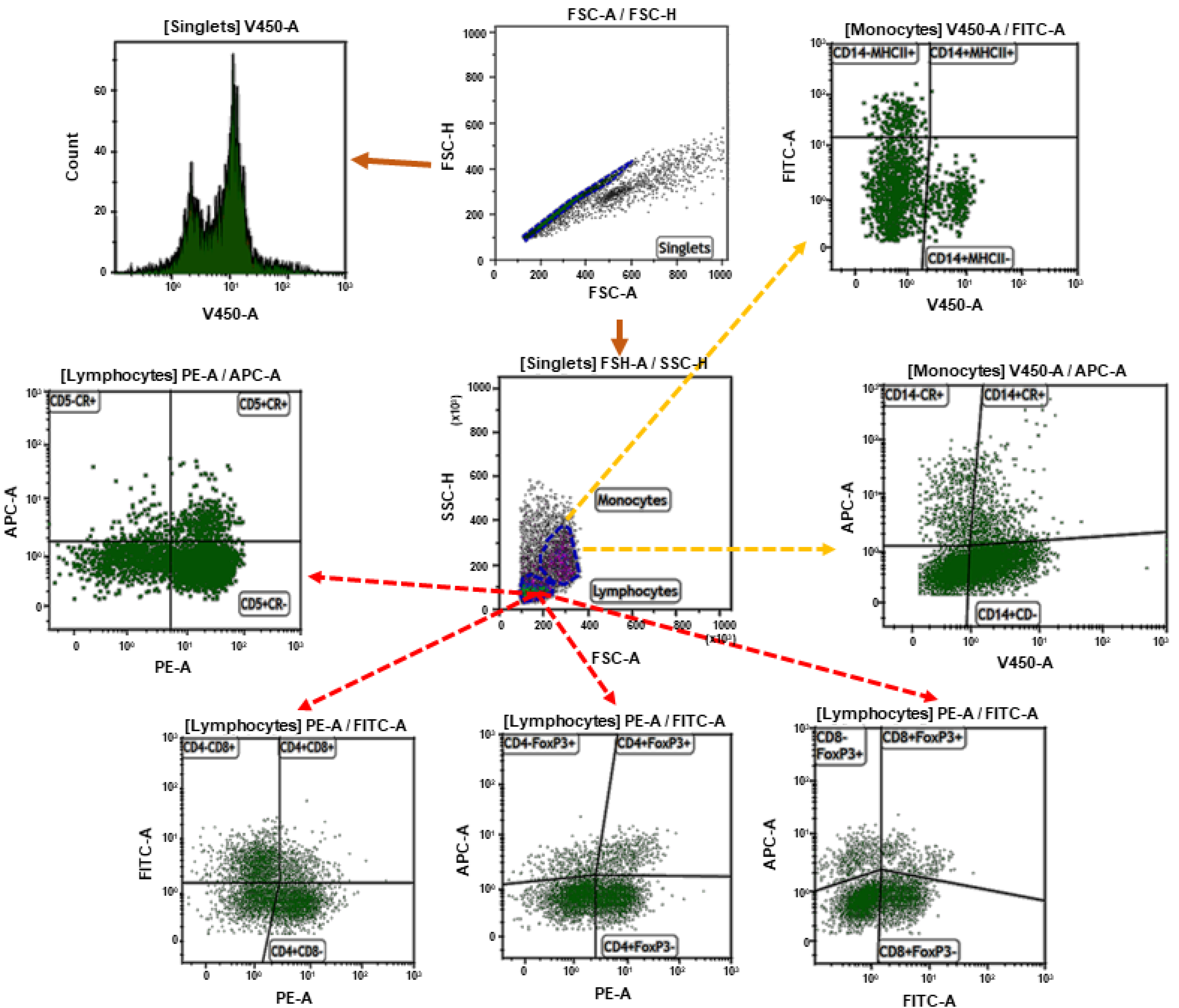

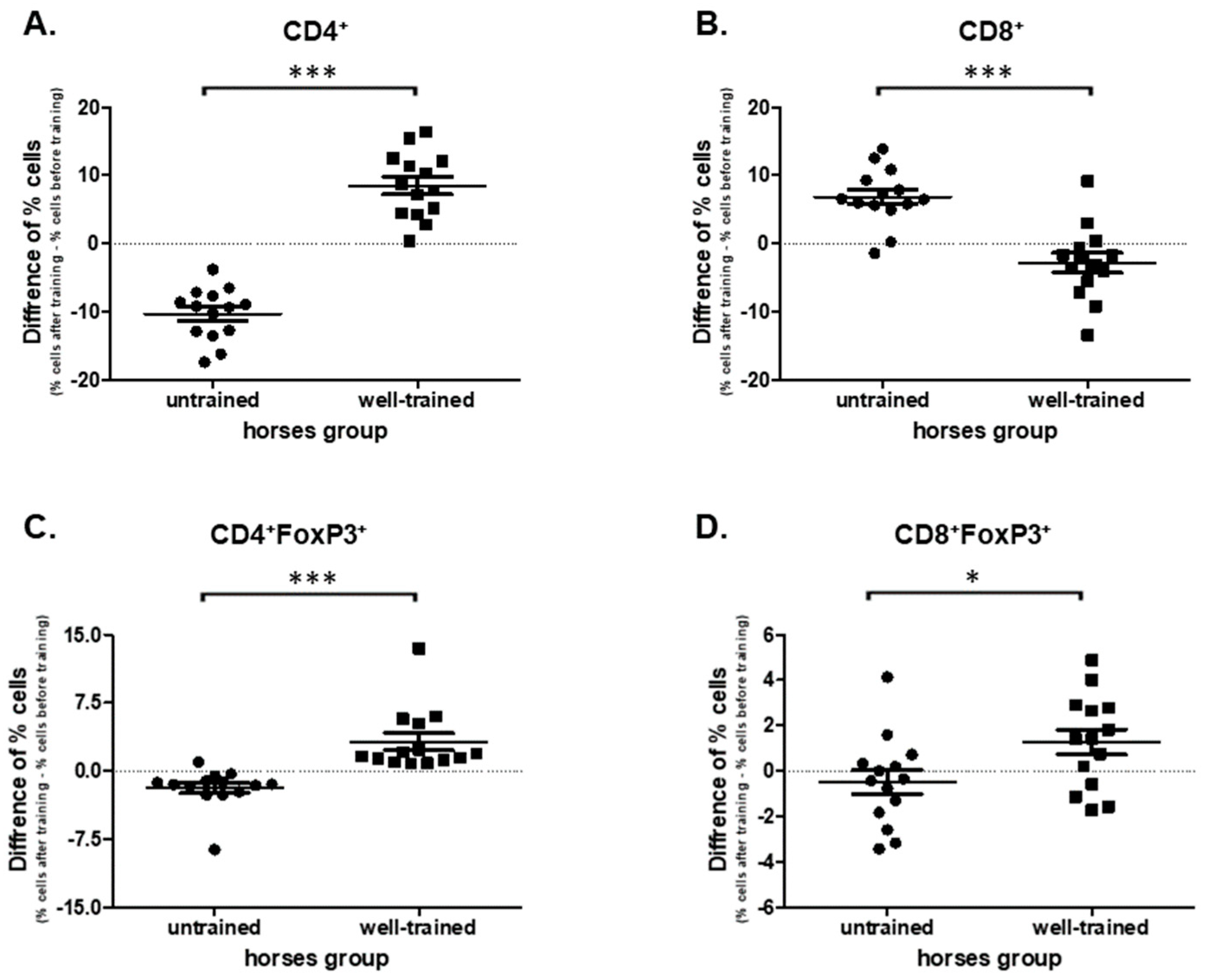
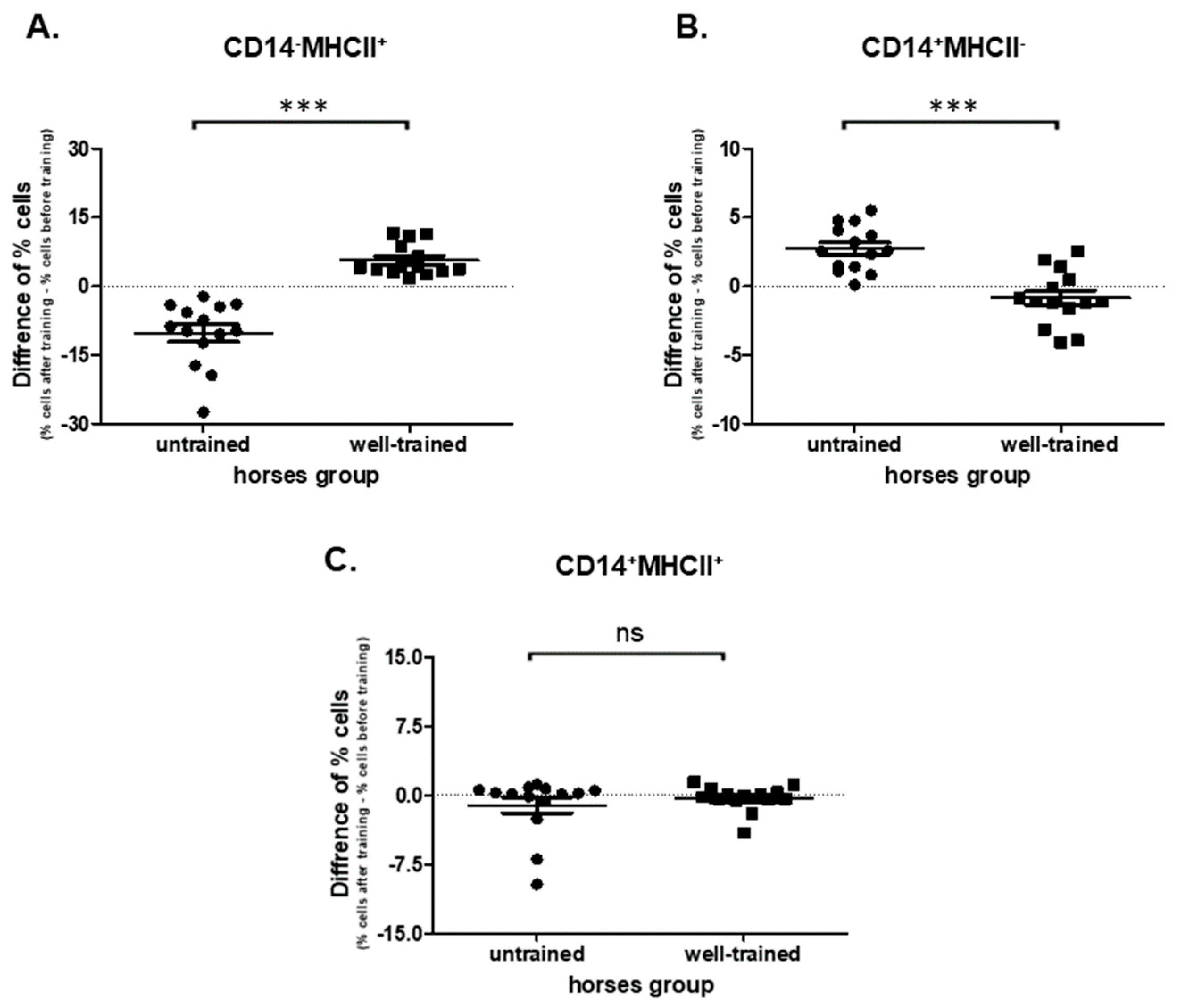
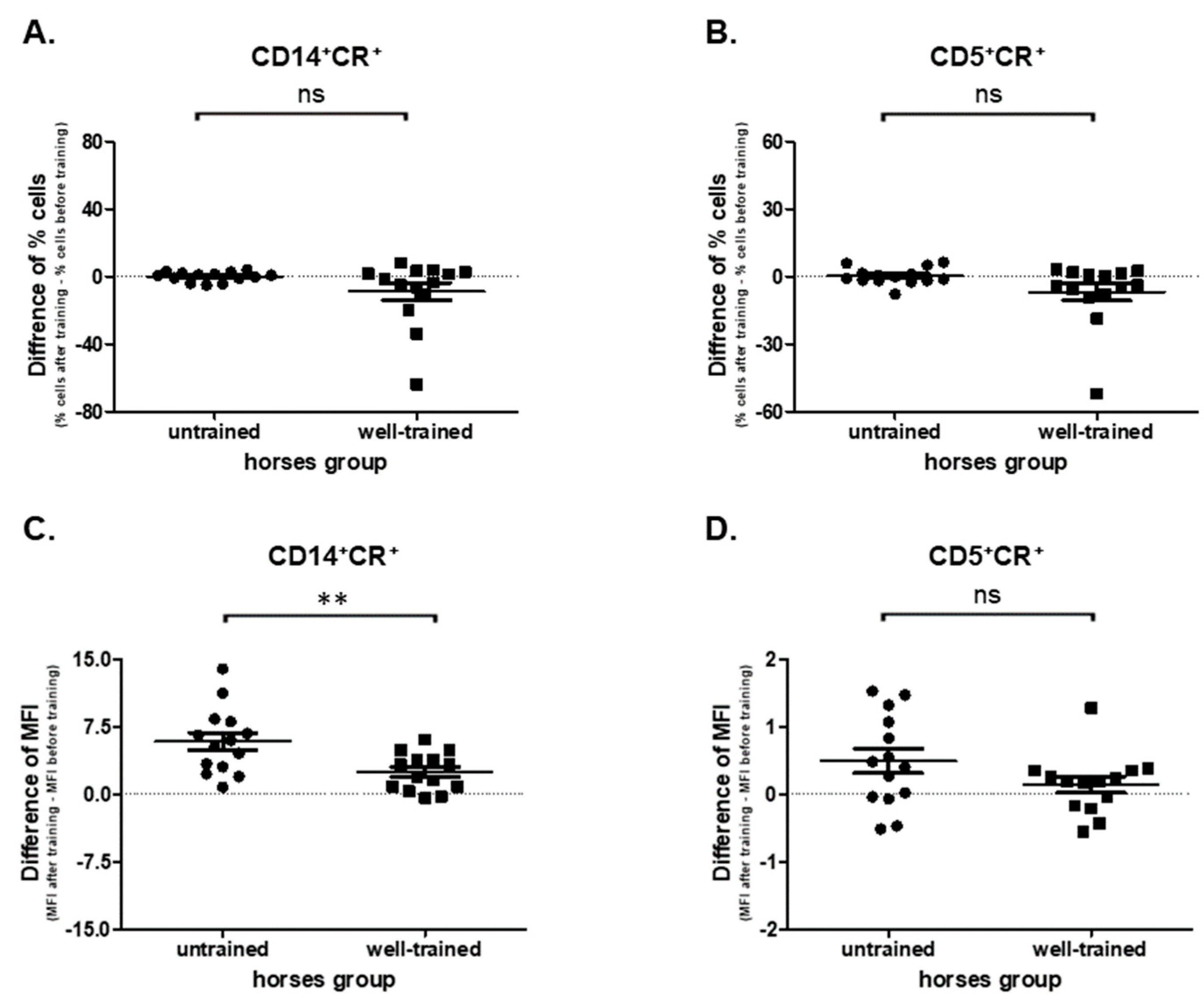
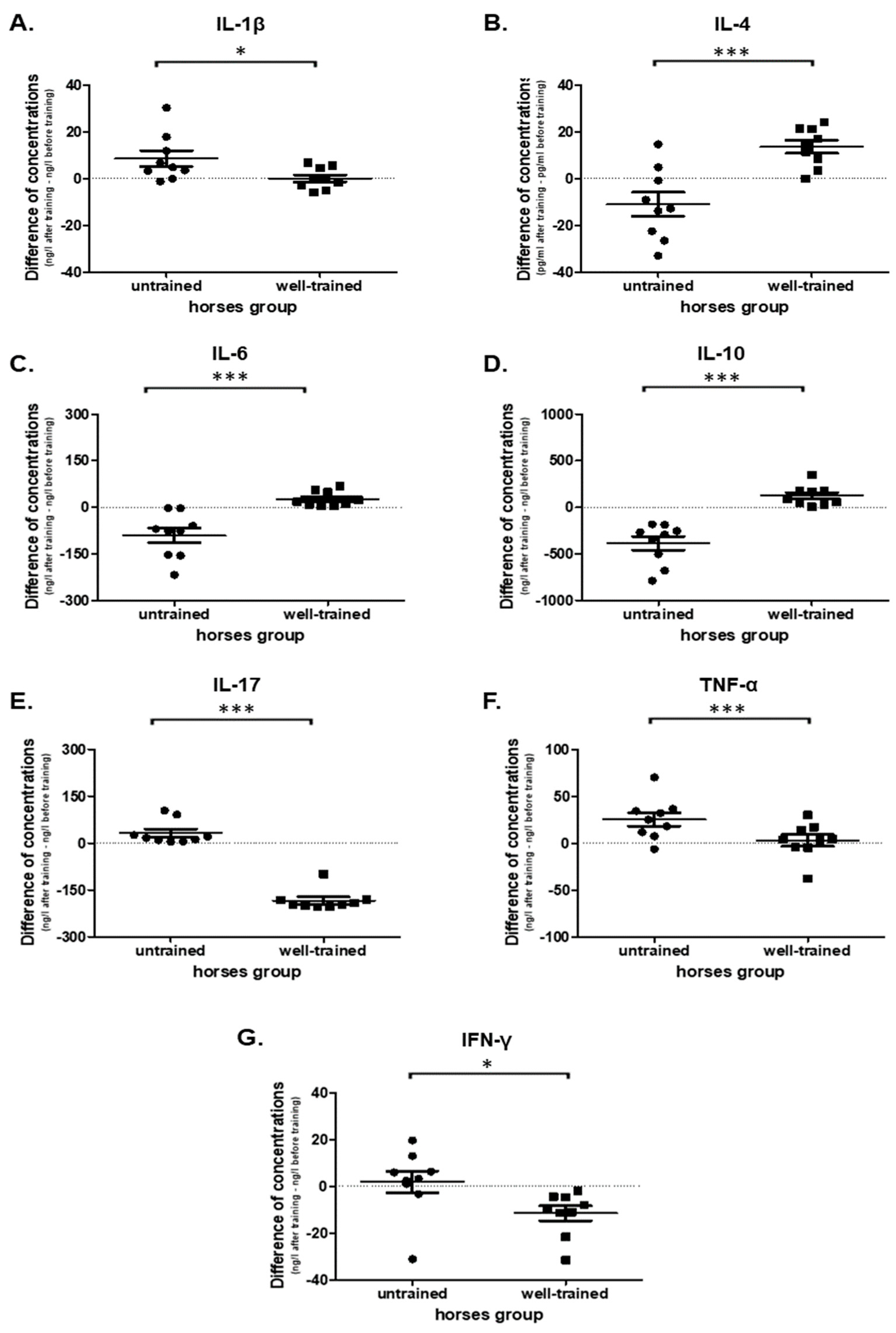
| Antibody | Clone; Dilution | Source | Target Cell |
|---|---|---|---|
| CD4:PE | CVS4; 1:10 | BioRad, Berkeley, CA, USA | lymphocytes |
| CD8:FITC | CVS21; 1:10 | BioRad, Berkeley, CA, USA | lymphocytes |
| CD5:PE | CVS5; 1:10 | BioRad, Berkeley, CA, USA | lymphocytes |
| CD14:AF405 | 433423; 1:10 | R&D Systems, Minneapolis, MI, USA | monocytes |
| MHCII:FITC | CVS20; 1:20 | BioRad, Berkeley, CA, USA | monocytes |
| FoxP3:APC | FJK-16s; 1:10 | Life Technologies, Bleiswijk, The Netherland; | lymphocytes |
Publisher’s Note: MDPI stays neutral with regard to jurisdictional claims in published maps and institutional affiliations. |
© 2020 by the authors. Licensee MDPI, Basel, Switzerland. This article is an open access article distributed under the terms and conditions of the Creative Commons Attribution (CC BY) license (http://creativecommons.org/licenses/by/4.0/).
Share and Cite
Witkowska-Piłaszewicz, O.; Pingwara, R.; Winnicka, A. The Effect of Physical Training on Peripheral Blood Mononuclear Cell Ex Vivo Proliferation, Differentiation, Activity, and Reactive Oxygen Species Production in Racehorses. Antioxidants 2020, 9, 1155. https://doi.org/10.3390/antiox9111155
Witkowska-Piłaszewicz O, Pingwara R, Winnicka A. The Effect of Physical Training on Peripheral Blood Mononuclear Cell Ex Vivo Proliferation, Differentiation, Activity, and Reactive Oxygen Species Production in Racehorses. Antioxidants. 2020; 9(11):1155. https://doi.org/10.3390/antiox9111155
Chicago/Turabian StyleWitkowska-Piłaszewicz, Olga, Rafał Pingwara, and Anna Winnicka. 2020. "The Effect of Physical Training on Peripheral Blood Mononuclear Cell Ex Vivo Proliferation, Differentiation, Activity, and Reactive Oxygen Species Production in Racehorses" Antioxidants 9, no. 11: 1155. https://doi.org/10.3390/antiox9111155
APA StyleWitkowska-Piłaszewicz, O., Pingwara, R., & Winnicka, A. (2020). The Effect of Physical Training on Peripheral Blood Mononuclear Cell Ex Vivo Proliferation, Differentiation, Activity, and Reactive Oxygen Species Production in Racehorses. Antioxidants, 9(11), 1155. https://doi.org/10.3390/antiox9111155





